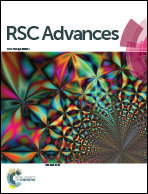Cu@CuO promoted g-C3N4/MCM-41: an efficient photocatalyst with tunable valence transition for visible light induced hydrogen generation†
Abstract
A series of ternary Cu@CuO–g-C3N4/MCM-41 photocatalysts have been synthesized by varying the percentage of Cu using simple impregnation and co-condensation methods. The physico-chemical characterization of all the samples was determined using XRD, FTIR, UV-Vis DRS, PL, N2 ads–des studies, SEM and XPS HRTEM, EDAX, EIS and MS. The structural advantages of MCM-41, allow the uniform distribution of g-C3N4 and coexistence of Cu2+ along with Cu0 without using a reducing agent. The presence of g-C3N4 helps to shift the Fermi level of CuO towards more negative values due to accumulation of photogenerated electrons on the surface. It favours charge separation by creating a Schottky barrier at the junction. The 4 wt% Cu loaded over g-C3N4/MCM-41 exhibits a maximum 750 μmol 2 h−1 of H2 evolution under visible light irradiation with an apparent energy conversion efficiency of 24.8%. The enhancement in catalytic activity has been explained on the basis of synergism between g-C3N4 and Cu2+ and the SPR effect of Cu which also acts as a co-catalyst present on the surface of photocatalysts.


 Please wait while we load your content...
Please wait while we load your content...